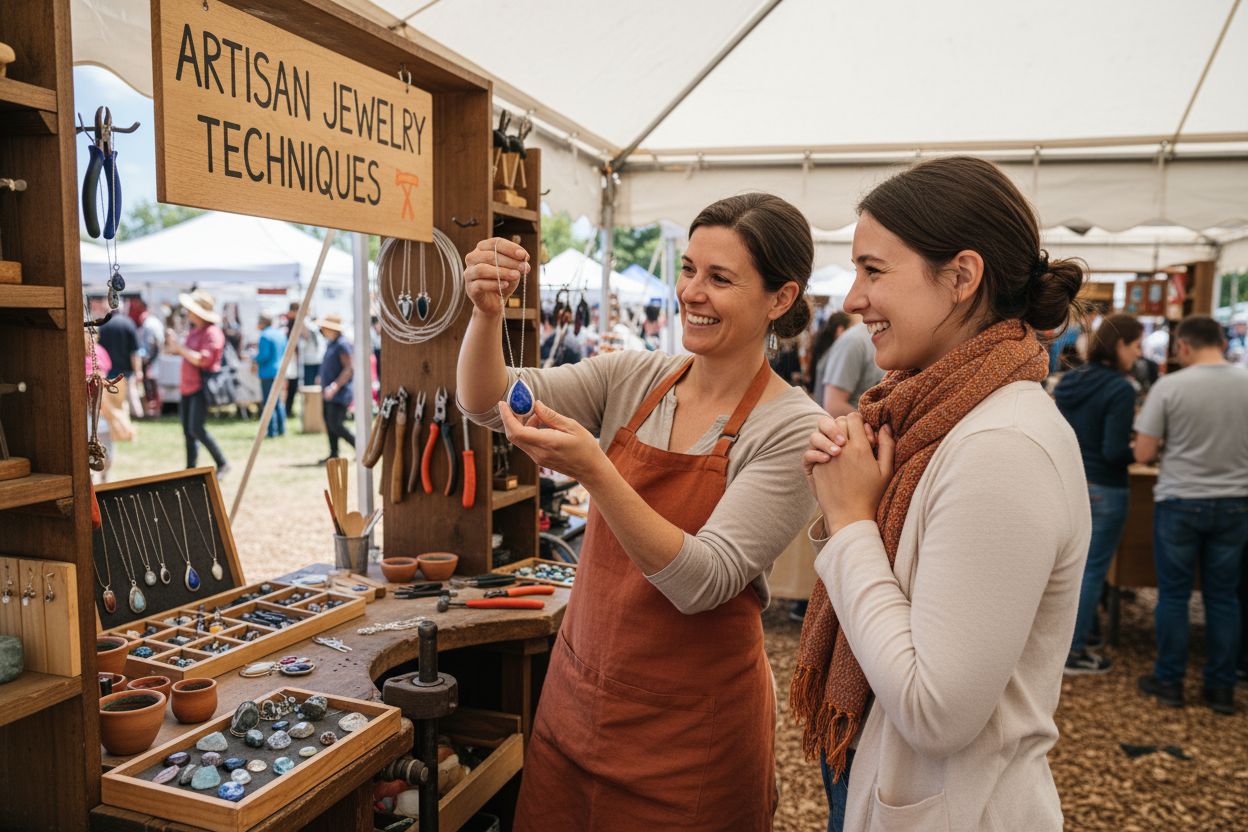Your cart (0)
Your cart is empty
Tax included and shipping calculated at checkout
Drawer menu
Tax included and shipping calculated at checkout
Handmade jewelry is so much more than a pretty accessory. Every piece is crafted by hand and no two are ever exactly alike, which sets it miles apart from generic factory-made designs. Mass production might rule store shelves, but true artistry still lives in the hands of skilled makers—and their originality might just surprise you.
| Takeaway | Explanation |
|---|---|
| Handmade jewelry is uniquely crafted. | Each piece is individually made by artisans, ensuring no two items are alike. This uniqueness reflects personal creativity and craftsmanship. |
| Artisan techniques enhance jewelry’s value. | Traditional methods like forging and stone setting contribute to the artistic quality and durability of each piece. |
| Choosing handmade supports local economies. | Purchasing handmade jewelry helps sustain artisan communities and preserves traditional craftsmanship through fair compensation. |
| Ethical fashion means conscious consumption. | Handmade jewelry offers an environmentally sustainable alternative, reducing waste and promoting responsible sourcing of materials. |
| Gemstones tell personal stories. | Each carefully selected gemstone carries cultural significance and enhances the emotional connection between the wearer and the piece. |
Handmade jewelry represents a profound artistic expression where skilled artisans transform raw materials into unique, personalized pieces through meticulous craftsmanship. Unlike mass-produced accessories, these creations embody individual creativity, cultural heritage, and exceptional technical skill. Handmade jewelry represents more than simple adornment - it is a narrative of human creativity and personal connection.
At its core, handmade jewelry involves creating intricate pieces entirely by hand, without relying on automated manufacturing processes. Artisans use traditional tools like hammers, pliers, files, and torches to shape metals, set stones, and design intricate patterns. Each piece emerges through direct manipulation of materials, reflecting the maker’s unique style, technical expertise, and creative vision.
Key characteristics of handmade jewelry include:
Handmade jewelry transcends mere decoration, serving as a powerful medium of cultural expression and artistic storytelling. Artisans often incorporate traditional techniques passed through generations, embedding cultural narratives and personal experiences into their designs. Read more about our approach to artisan craftsmanship to understand the deeper meaning behind each piece.
By choosing handmade jewelry, individuals support independent artists, preserve traditional crafting techniques, and invest in pieces that carry genuine emotional and artistic value. These accessories become more than accessories - they are wearable art that connects the wearer to the rich tradition of human creativity and skill.
Handmade jewelry emerges from a carefully curated selection of materials that elevate each piece from simple accessory to extraordinary artwork. The choice of materials directly influences the jewelry’s aesthetic, durability, emotional resonance, and intrinsic value. Understanding these materials reveals the depth of craftsmanship behind every handmade creation.
Precious metals form the cornerstone of handmade jewelry, with each metal bringing unique characteristics to the design. Silver, gold, and platinum are not merely structural elements but storytelling mediums. Sterling silver offers affordability and versatility, while pure gold provides luxurious warmth and resistance to tarnishing. Artisans often combine different metal types to create complex, layered designs that showcase technical skill and creative vision.
Key considerations in metal selection include:
Gemstones transform handmade jewelry from beautiful objects into personal narratives. Each stone carries unique geological history, color spectrum, and cultural significance. Artisans carefully select and set stones not just for visual appeal, but for their individual character. Learn more about our artisan gemstone selection process to understand the nuanced approach to stone integration.
From vibrant turquoise representing Native American traditions to delicate opals capturing Australian landscape hues, gemstones become more than decorative elements - they are cultural ambassadors embedded within wearable art. Handmade jewelry celebrates these stones’ natural beauty, often featuring minimalist settings that allow their inherent qualities to shine.
Handmade jewelry creation is a complex art form that blends centuries-old techniques with individual artistic expression. Metalworking techniques represent a delicate balance between technical precision and creative imagination, transforming raw materials into wearable masterpieces through intricate processes that demand extraordinary skill and patience.
Artisans employ a range of sophisticated techniques to shape and manipulate metals. Techniques like forging involve heating metal and hammering it into desired shapes, while soldering allows different metal pieces to be permanently joined. Casting enables complex designs by pouring molten metal into precisely crafted molds, allowing for intricate details that would be impossible through direct manipulation.
Key metalworking techniques include:
Stone setting represents another critical skill in jewelry creation. Artisans must carefully select and position gemstones, ensuring they are securely held while maximizing their natural beauty.
Discover more about our approach to artisan jewelry design and the intricate techniques that make each piece unique.
Techniques like prong setting, bezel setting, and pavé setting each offer different aesthetic and structural approaches. The final finishing process involves careful polishing, which enhances the metal’s luster and ensures the piece meets the highest standards of craftsmanship. Each step requires not just technical skill, but an artistic vision that transforms raw materials into wearable art.
The table below outlines key metalworking and stone setting techniques mentioned in the article, highlighting the role each technique plays in shaping and finishing handmade jewelry.
| Technique | Description | Purpose |
|---|---|---|
| Forging | Heating and hammering metal to form desired shapes | Creates structure and form |
| Soldering | Joining metal pieces using a filler metal and high heat | Permanently bonds components |
| Casting | Pouring molten metal into precise molds | Achieves complex and intricate designs |
| Hammering | Shaping metal using controlled physical force | Adds texture, dimension, or basic shaping |
| Annealing | Heating metal to increase malleability | Softens metal for easier working |
| Texturing | Creating patterns on the metal surface | Adds decorative visual interest |
| Prong Setting | Securing gemstones with metal prongs | Holds stones visibly and securely |
| Bezel Setting | Encircling a gemstone with a rim of metal | Offers protection and sleek design |
| Pavé Setting | Setting small stones closely with small amounts of metal visible | Produces a sparkling, stone-heavy surface |
In a world saturated with mass-produced accessories, handmade jewelry emerges as a powerful statement of individuality, craftsmanship, and personal expression. The contemporary fashion landscape increasingly values unique, ethically created pieces that tell a story beyond mere aesthetic appeal. Research on fashion trends demonstrates a growing consumer preference for artisanal and personalized products.
Handmade jewelry transcends traditional fashion accessories by offering unparalleled individuality. Each piece represents a personal narrative, reflecting the artisan’s creativity and the wearer’s distinct style. Unlike mass-produced jewelry that can be replicated thousands of times, handmade pieces carry subtle variations that make them truly one-of-a-kind. These unique characteristics allow individuals to express their personality through accessories that cannot be found in mainstream retail stores.

Key advantages of handmade jewelry in fashion include:
Contemporary fashion consumers are increasingly conscious about the environmental and social impact of their purchases. Explore our commitment to artisanal craftsmanship and understand how handmade jewelry represents a more sustainable and ethical fashion choice. Handmade jewelry often involves smaller production scales, reduced waste, fair compensation for artisans, and environmentally responsible material sourcing. By choosing handmade pieces, fashion enthusiasts support independent artists, preserve traditional craft techniques, and make a statement about their values beyond aesthetic preferences.
Handmade jewelry represents far more than a fashion statement; it embodies a profound commitment to environmental sustainability and ethical production practices. As global consciousness about consumption grows, artisan jewelry emerges as a powerful alternative to mass-produced accessories that often generate significant environmental waste and unethical manufacturing conditions.
The production of handmade jewelry inherently supports environmental conservation through mindful material selection and production techniques. Artisans typically work with smaller quantities of materials, minimizing industrial waste and reducing the carbon footprint associated with large-scale manufacturing. Sustainable production research demonstrates that localized, small-scale production significantly decreases environmental impact compared to global industrial manufacturing.
Key environmental benefits include:
Beyond environmental considerations, handmade jewelry plays a critical role in supporting local economies and preserving traditional craftsmanship. Learn more about our commitment to artisan empowerment and understand how each purchase contributes to sustainable community development. By choosing handmade pieces, consumers directly support skilled artisans, enabling them to maintain traditional techniques while earning fair compensation. This economic model promotes cultural preservation, provides meaningful employment, and creates a more equitable global production ecosystem.

You have learned how each piece of handmade jewelry tells a story through skill, tradition, and personal touch. Now you can find jewelry that truly matches what you value. If you are searching for one-of-a-kind, customizable pieces with deep meaning and outstanding craftsmanship, our Featured Collection offers stunning examples of what handmade jewelry can achieve.

Take the next step and bring your own vision to life today. Discover how you can own unique, dramatic jewelry created especially for you. Visit Jared Daniel Designs to explore our collection or learn more at Robbie’s Corner. Every piece is made to be cherished and worn every day. Start your handmade jewelry journey now and experience the difference for yourself.
Handmade jewelry is characterized by unique designs and meticulous craftsmanship, whereas mass-produced jewelry is manufactured using automated processes, resulting in uniform and often lower-quality pieces.
To help readers quickly compare handmade and mass-produced jewelry, the table below summarizes their main differences in terms of process, uniqueness, quality, and ethical impact.
| Aspect | Handmade Jewelry | Mass-Produced Jewelry |
|---|---|---|
| Process | Crafted individually by artisans using traditional methods | Manufactured using automated, industrial processes |
| Uniqueness | Each piece is one-of-a-kind | Designs are uniform and identical |
| Quality | Higher attention to detail and superior craftsmanship | Often lower-quality due to bulk production |
| Artistic Value | Expresses personal creativity and cultural heritage | Limited originality; focuses on mass appeal |
| Ethical & Environmental Impact | Supports local artisans, fair pay, and sustainability | May involve unfair labor and higher environmental cost |
Handmade jewelry typically features precious metals like gold, silver, and platinum, as well as a variety of gemstones. These materials are chosen for their aesthetic appeal, durability, and cultural significance.
Creating handmade jewelry involves various traditional metalworking techniques such as forging, soldering, and casting. Each technique requires skill and artistic vision to transform raw materials into finished pieces.
Handmade jewelry supports sustainability by utilizing small-scale production methods, reducing waste, and promoting responsible material sourcing. This approach minimizes the environmental impact associated with mass manufacturing and fosters ethical practices.